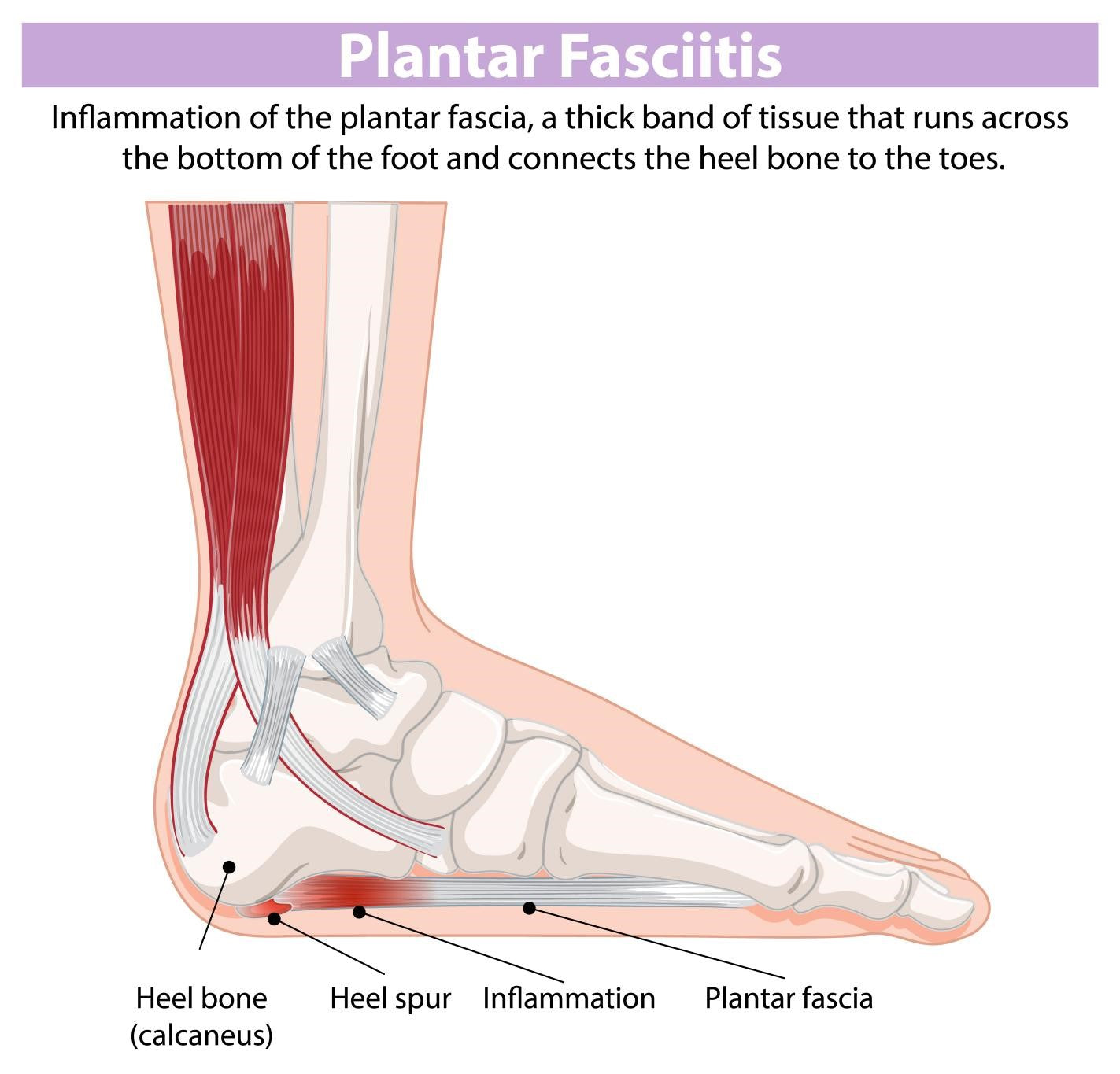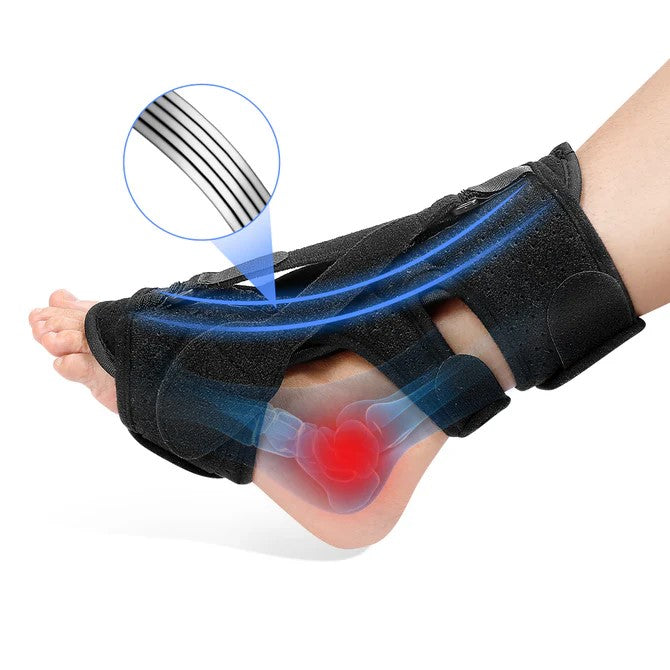Does Plantar Fasciitis Cause Ankle Pain?

Every year, millions of patients with plantar fasciitis visit hospitals for treatment. The majority of adult patients are between the ages of 25 and 65[1].
However, does Plantar Fasciitis cause ankle pain?
Though Plantar Fasciitis is primarily known for causing heel pain, it does cause ankle pain due to its biochemical and anatomical connections. Buckle up as we explore the association of Plantar Fasciitis with ankle pain, its common causes and symptoms, and how we can treat it.

Plantar Fasciitis
There is a fibrous tissue in our foot called plantar fascia that is responsible for connecting the toes to our heel bone. In plantar fasciitis, there is an inflammation of the plantar fascia along the foot bottom. The patient suffers from intense stabbing heel pain. The prevalence of the pain is higher in the morning.
It's known as the most commonly found orthopedic issue because the bottom of the foot is a site that experiences wear and tear the most. People who are involved in high-impact activities and don't pay much attention to their feet are most likely affected by it. Plantar fasciitis affects both athletes and sedentary individuals.
Association of Plantar Fasciitis with Ankle Pain
When there is too much stretching of the plantar fascia, or it is subjected to high tension, it affects the entire foot, including the ankle. Ankle pain from plantar fasciitis may also occur due to the following perspectives:
- Compensatory Movements: When there's an increased tension on the plantar fascia, the gait is altered and it leads to compensatory movements that further stress the ankle joint. It may also result in discomfort that radiates to the foot upwards.
- Biomechanical Strain: Plantar fasciitis changes the biomechanics of weight distribution across the foot. The inflammation and tightness of the plantar fascia affect the movement patterns of the foot. These altered mechanics further put stress on the ankle joint and lead to pain.
- Shared Anatomy: A network of muscles, tendons, and ligaments intricately connect the foot and ankle. When the mechanics of the foot are altered due to plantar fasciitis, the delicate balance between these structures is also impacted. The stability and function of the ankle joint are both affected. It'll manifest as plantar tendon pain.
- Overlapping Symptoms: Sometimes plantar fasciitis looks like ankle pain but may relate to a completely different issue, like tendonitis or a sprained ankle. However, due to shared common symptoms such as tenderness, swelling, and stiffness, it gets difficult to differentiate. Therefore, if you experience foot or ankle pain, it is recommended to consult a doctor or physiotherapist to receive proper assessment and treatment advice.
Common Causes and Symptoms of Plantar Fasciitis
The most common cause of ankle pain from plantar fasciitis is fasciitis injury. This injury occurs due to repetitive strain that results in micro-tears of plantar tissues. Other causes of this condition include:
- Trauma
- Prolonged jumping or standing
- Limited ankle dorsiflexion
- Excessive supination and pronation
- Pes Planus (also known as flat feet)
- Pes Cavus (in this condition, the arch of the foot is abnormally raised)
- Nerve entrapments (such as tarsal tunnel syndrome)
Other causes of plantar fasciitis among runners and older people include
- Heel pad atrophy (a condition in which the natural fat pad cushioning underneath the heel of the foot becomes thinner)
- Obesity
- Long-standing occupations
- Aging
- Weight-bearing exercises
Patients with plantar fasciitis often have a history of progressive pain at the medial and inferior heel. This pain may radiate to other parts, including the ankle. The ankle pain with plantar fasciitis is another manifestation that may arise. There is an increase in the pain intensity as the patient takes a few steps out of bed in the morning.
The pain may also arise if the patient sits for prolonged periods. When involved in a physical activity, the pain decreases a bit, but again, it increases and radiates to the ankle as there is an increase in the activity.
Here’s a summary of the most common symptoms of plantar fasciitis:
- Pain at the bottom of the heel
- Stiffness
- Pain in the arch of the foot
- Tension or discomfort in the Achilles tendon area
- Swelling around the heel
How to Treat Plantar Fasciitis?
Where before this injury, one may have a spring in his step during morning jogs; now, plantar fasciitis can make each step painful.
However, implementing the right treatment plan into the routine can help alleviate ankle pain and easy recovery from plantar fasciitis. Here are some lifestyle modifications that significantly help improve the symptoms:
- Rest: Rest is the first-line treatment for plantar fasciitis. Depending upon the intensity of pain, administering adequate rest from offending activities helps alleviate pain.
- Deep friction massage: Deep friction massage of the insertion and arch improves the symptoms to a great extent. This technique, when performed correctly by a professional, may help break down scar tissue and improve symptoms.
- Stretching exercises: After waking up in the morning, stretching the arches of the feet with breaks in between relaxes the feet and ankles. It helps in short-term relief from the pain and healing long-term.
- Orthopedic ankle brace: The ankle brace for plantar fasciitis is an effective injury prevention and treatment method. But do ankle braces help plantar fasciitis? High-quality ankle braces such as those from Fivali provide stability and support, promoting recovery and preventing re-injury. These braces restrict the motion, provide appropriate pressure, and promote blood circulation to ensure speedy recovery from the pain.

- Good posture: Maintain a good posture by standing up straight and equally applying pressure on both your feet. This activity relieves pain and strain in your ankles and feet.
- Shock-absorbing footwear: Patients who have plantar fasciitis should always take care of their shoes. It is wise to buy shoes with generous cushioning to absorb stress. An ankle brace with arch support also provides excellent cushioning. It's a great investment for anyone who does not want to buy shock-absorbing shoes.
- Reduce inflammation: Reducing inflammation is the standard treatment approach for those suffering from plantar fasciitis. Using ice and Advil (pain relief medication) can help improve the symptoms. In some cases, the doctors may inject corticosteroids into the fascia or on the skin of the heels.
- Reserve surgery: It is usually the last option when all the physical therapies have failed. If the patient does not respond to non-invasive treatment methods for six to twelve months, fasciotomy (surgery) is done. However, surgery does not promise high-end results. Also, there is an increased risk of nerve injury involved with this method.
We hope this article helped you with everything from knowing does Plantar Fasciitis causes ankle pain to the effective measures you can take.
To ensure the optimum wellness of ankles and recovery from ankle pain due to plantar fasciitis, adjustable ankle support braces work wonders. You can choose from Fivali’s diverse range of ankle braces.
References:
[1] Plantar fasciitis: Symptoms, causes, and treatments. Available at: https://www.health.harvard.edu/pain/plantar-fasciitis-symptoms-causes-and-treatments (Accessed: 19 June 2024)
-
Posted in
Healthy Lifestyle, Joint, Pain













